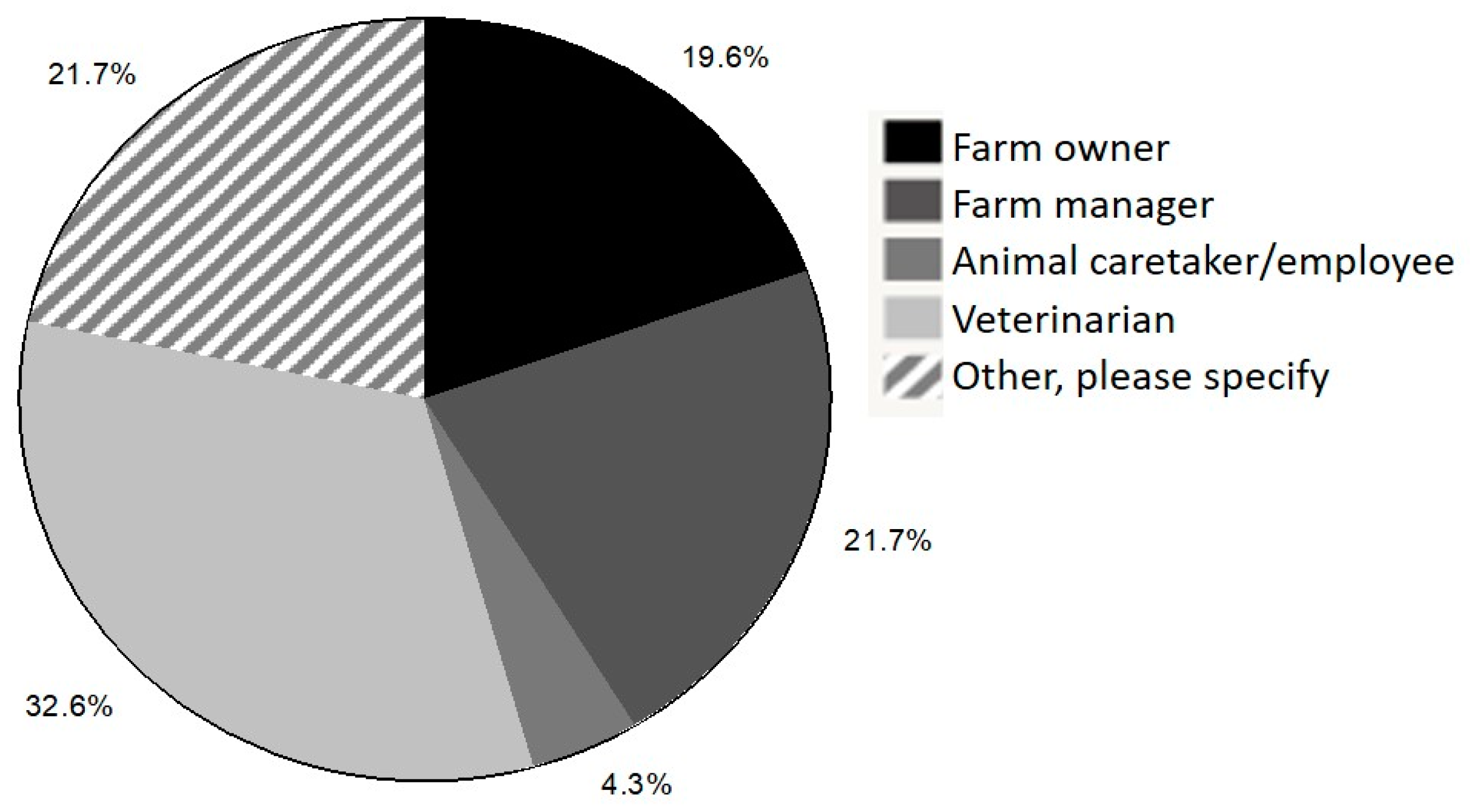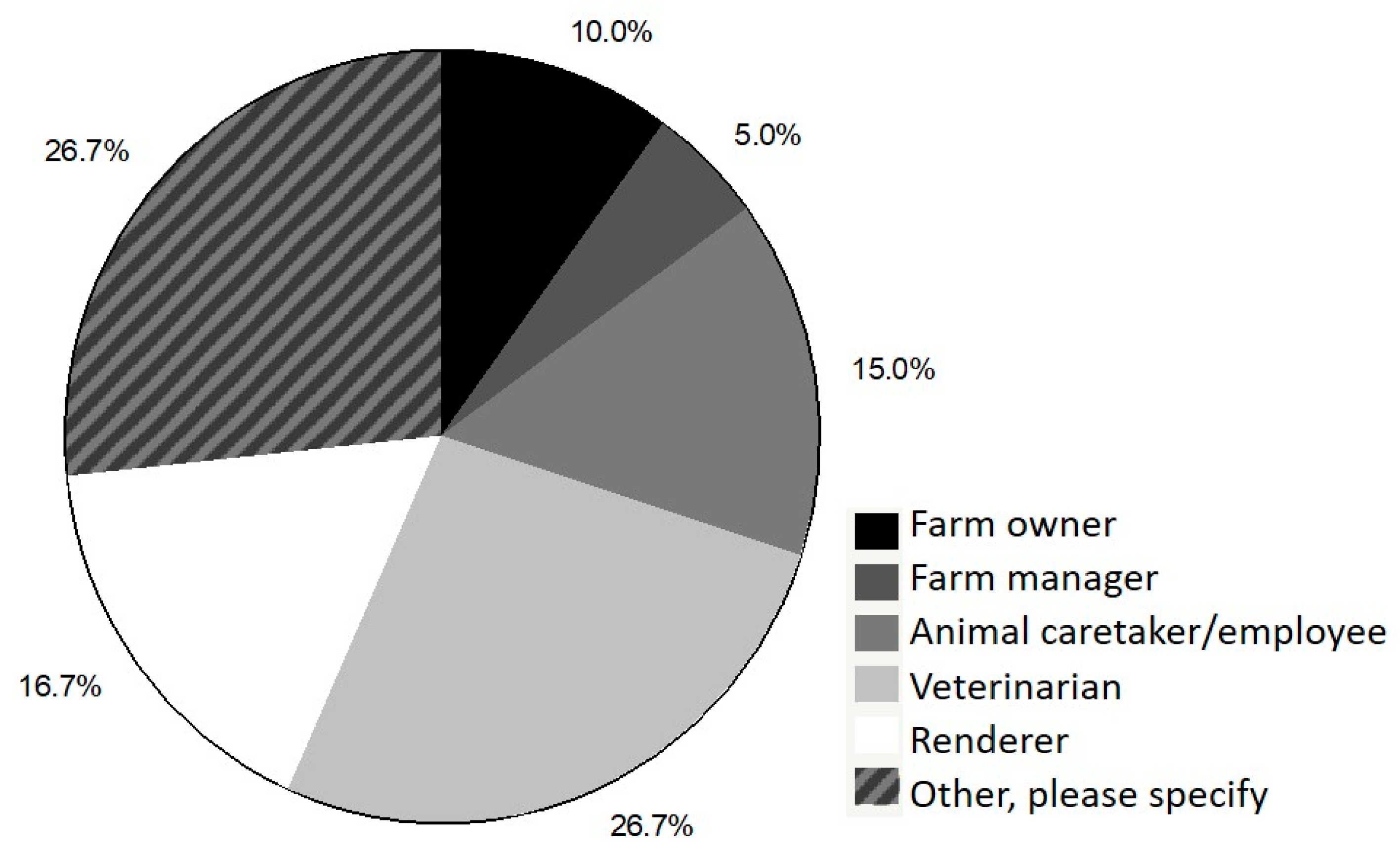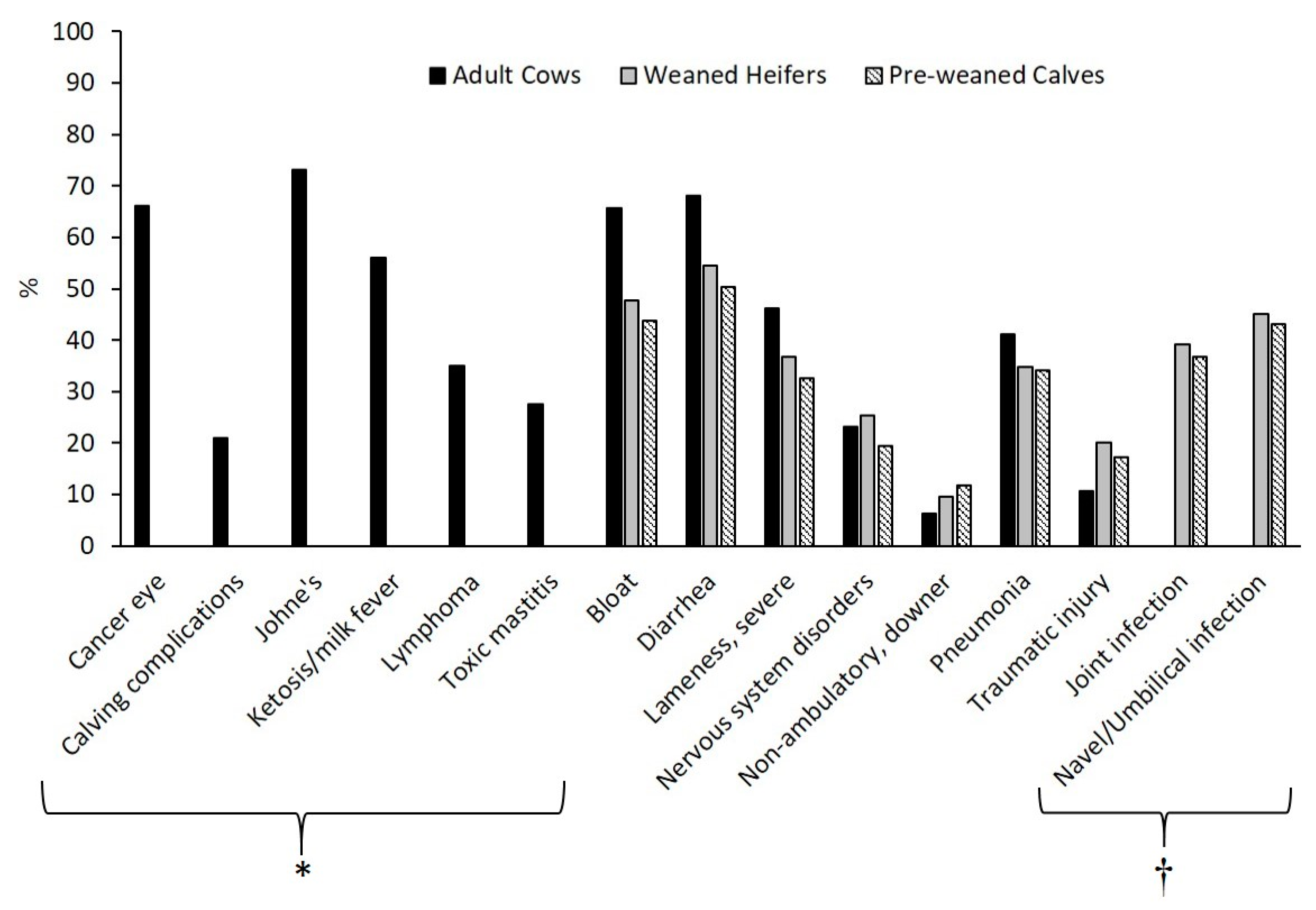Determination of Dairy Cattle Euthanasia Criteria and Analysis of Barriers to Humane Euthanasia in the United States: Dairy Producer Surveys and Focus Groups
Abstract
Simple Summary
Abstract
1. Introduction
2. Materials and Methods
2.1. Part I: Survey
2.1.1. Development and Participant Recruitment
2.1.2. The Survey
2.1.3. Data Analysis
2.2. Part II: Focus Group
2.2.1. Development and Participant Recruitment
2.2.2. Focus Group Format
2.2.3. Discussion Analysis
3. Results
3.1. Part I: Demographics
3.2. Part I: Decision Making about Health Conditions
3.3. Part II: Focus Group Participation and Outcomes
4. Discussion
4.1. Reliance upon Farm Owners and External Guidance
4.2. Human Psychology and Emotions
4.3. Inconsistent Health Condition Management and Euthanasia Timelines
5. Conclusions
Author Contributions
Funding
Acknowledgments
Conflicts of Interest
Appendix A
| Q# | Question Text | Response Options |
|---|---|---|
| 2.1 | What is your age? | Text box provided |
| 2.2 | What is your gender? | Male Female Other Prefer not to answer |
| 2.3 | Approximately how long have you worked with dairy cattle? | Text box provided |
| 2.4 | What is your highest level of education? | Some high school High school diploma/GED Associates degree/certificate Bachelor’s degree Graduate degree (e.g., MS, MBA, PhD)/ professional degree (e.g., DVM) |
| 2.5 | Approximately how many adult cows (lactating and dry) are on the facility where you currently work? | Text box provided |
| 2.6 | Approximately how many heifers and calves are on the facility where you currently work? | Text box provided |
| 2.7 | With which of the following cattle groups do you currently work? (select all that apply) | Pre-weaned calves Weaned heifers Mature cows Bulls |
| 2.8 | Which of the following best describes your role on the dairy facility where you currently work? | Farm owner Farm manager Animal caretaker/employee Veterinarian Other, please specify: Text box provided |
| 2.9 | In the past 12 months, have any dairy cattle been euthanized on the facility where you currently work? | Yes No |
| If yes → Q2.10: Which groups of dairy cattle have you euthanized? (select all that apply) | Dairy bulls or dairy yearling bulls Dairy steers/beef Pre-weaned calves (calves still on milk) Weaned heifers Adult cows | |
| 2.11 | Who performs most euthanasia on the facility where you currently work? | I do Someone else (see Figure 1) |
| If someone else → Q2.12: If someone else performs most euthanasia, what is this person’s role? | Farm owner Farm manager Animal caretaker employee Veterinarian Renderer, how frequently does the renderer come to this facility?: Text box provided Other, please specify: Text box provided | |
| 2.14 | Who makes most of the decisions on the facility to euthanize an animal? | I do Someone else (see Figure 2) |
| If someone else → Q2.15: If someone else makes most of the decisions to euthanize an animal, what is this person’s role? | Farm owner Farm manager Animal caretaker /employee Veterinarian Other, please specify: Text box provided | |
| 2.16 | Do you have a written protocol for dairy cattle euthanasia on the facility where you currently work? | Yes No |
| If yes → Q2.17: Was the written euthanasia protocol developed in consultation with the farm veterinarian? | Yes | |
| No | ||
| 2.18 | In the past 12 months, how often was the farm veterinarian consulted before euthanizing dairy cattle (lactating dairy cows, dairy heifers, dairy calves) on the facility where you currently work? | Always/every case |
| Often/most cases | ||
| Sometimes/a few cases | ||
| Never/no cases |
References
- Green, M.J.; Bradley, A.J.; Medley, G.F.; Browne, W.J. Cow, Farm, and Management Factors During the Dry Period that Determine the Rate of Clinical Mastitis After Calving. J. Dairy Sci. 2007, 90, 3764–3776. [Google Scholar] [CrossRef] [PubMed]
- Shearer, J.K.; Reynolds, J.P. Euthanasia techniques for dairy cattle. In Dairy Production Medicine; Risco, C.A., Melendez Retamel, P., Eds.; Blackwell Publishing: Oxford, UK, 2011; pp. 331–339. [Google Scholar] [CrossRef]
- NMPF. Farmer’s Assuring Responsible Management Program. Available online: https://nationaldairyfarm.com/wp-content/uploads/2020/01/transportationguidelines-2019.pdf (accessed on 26 April 2020).
- AABP. Practical Euthanasia of Cattle. American Association of Bovine Practitioners: Auburn, AL, USA, 2013; pp. 1–7. [Google Scholar]
- Arluke, A. Managing Emotions in an Animal Shelter; Manning, A., Serpell, J., Eds.; Routledge: New York, NY, USA, 1994; pp. 145–165. [Google Scholar]
- Reeve, C.L.; Rogelberg, S.G.; Spitzmüller, C.; Digiacomo, N. The Caring-Killing Paradox: Euthanasia-Related Strain among Animal-Shelter Workers. J. Appl. Soc. Psychol. 2005, 35, 119–143. [Google Scholar] [CrossRef]
- Joinson, C. Coping with compassion fatigue. Nursing 1992, 116, 116–121. [Google Scholar]
- Habing, G.; Djordjevic, C.; Schuenemann, G.M.; Lakritz, J. Understanding antimicrobial stewardship: Disease severity treatment thresholds and antimicrobial alternatives among organic and conventional calf producers. Prev. Vet. Med. 2016, 130, 77–85. [Google Scholar] [CrossRef] [PubMed]
- USDA-APHIS-NAHMS. Dairy: Health and Management Practices on U.S. Dairy Operations. Available online: https://www.aphis.usda.gov/animal_health/nahms/dairy/downloads/dairy14/Dairy14_dr_PartIII.pdf (accessed on 26 April 2020).
- Mullins, C.R.; Pairis-Garcia, M.D.; George, K.A.; Anthony, R.; Johnson, A.K.; Coleman, G.J.; Rault, J.-L.; Millman, S.T. Determination of swine euthanasia criteria and analysis of barriers to euthanasia in the United States using expert opinion. Anim. Welf. 2017, 26, 449–459. [Google Scholar] [CrossRef]
- Green, A.L.; Lombard, J.E.; Garber, L.P.; Wagner, B.A.; Hill, G.W. Factors associated with occurrence and recovery of nonambulatory dairy cows in the United States. J. Dairy Sci. 2008, 91, 2275–2283. [Google Scholar] [CrossRef] [PubMed]
- Stull, C.; Reynolds, J. Calf Welfare. Vet. Clin. Food Anim. 2008, 24, 191–203. [Google Scholar] [CrossRef] [PubMed]
- Fulwider, W.K.; Grandin, T.; Rollin, B.E.; Engle, T.E.; Dalsted, N.L.; Lamm, W.D. Survey of dairy management practices on one hundred thirteen north central and northeastern United States dairies. J. Dairy Sci. 2008, 91, 1686–1692. [Google Scholar] [CrossRef]
- Douphrate, D.I.; Hagevoort, G.R.; Nonnenmann, M.W.; Lunner Kolstrup, C.; Reynolds, S.J.; Jakob, M.; Kinsel, M. The dairy industry: A brief description of production practices, trends, and farm characteristics around the world. J. Agromed. 2013, 18, 187–197. [Google Scholar] [CrossRef] [PubMed]
- Cabrera, V.E.; Hagevoort, R.; Solis, D.; Kirksey, R.; Diemer, J.A. Economic impact of milk production in the State of New Mexico. J. Dairy Sci. 2008, 91, 2144–2150. [Google Scholar] [CrossRef]
- Lai, J.; Olynk Widmar, N.J.; Wolf, C.A. Dairy farm management priorities and implications. Int. Food Agribus. Manag. Rev. 2019, 22, 15–29. [Google Scholar] [CrossRef]
- Lord, L.K.; Millman, S.T.; Carbone, L.; Cook, N.; Fisher, A.; McKeegan, D.; Morton, D.; Pajor, E.; Peralta, J.M.; Robertson, S.A.; et al. A model curriculum for the study of animal welfare in colleges and schools of veterinary medicine. J. Am. Vet. Med Assoc. 2017, 250, 632–640. [Google Scholar] [CrossRef]
- Edwards-Callaway, L.N. Human-animal interactions: Effects, challenges, and progress. In Advances in Cattle Welfare; Tucker, C.B., Ed.; Elsevier Ltd.: Cambridge, MA, USA, 2018. [Google Scholar] [CrossRef]
- Thomsen, P.T.; Sørensen, J.T. Euthanasia of Danish dairy cows evaluated in two questionnaire surveys. Acta Vet. Scand. 2008, 50, 1–5. [Google Scholar] [CrossRef] [PubMed]
- Weary, D.M.; Huzzey, J.M.; von Keyserlingk, M.A.G. BOARD-INVITED REVIEW: Using behavior to predict and identify ill health in animals. J. Anim. Sci. 2009, 87, 770–777. [Google Scholar] [CrossRef] [PubMed]
- Johnson, R.W. The concept of sickness behavior: A brief chronological account of four key discoveries. Vet. Immunol. Immunopathol. 2002, 87, 443–450. [Google Scholar] [CrossRef]
- Walker, J.B.; Roman-Muniz, I.N.; Edwards-Callaway, L.N. Timely Euthanasia in the United States Dairy Industry-Challenges and a Path Forward. Animals 2020, 10, 71. [Google Scholar] [CrossRef] [PubMed]
- Cox, V.S.; Marsh, W.E.; Steuernagel, G.R.; Fletcher, T.F.; Onapito, J.S. Downer cow occurence in Minnesota dairy herds. Prev. Vet. Med. 1986, 4, 249–260. [Google Scholar] [CrossRef]
- AABP. Guidelines for the Humane Euthanasia of Cattle. 2019. Available online: https://www.aabp.org/Resources/AABP_Guidelines/EUTHANASIA-2019.pdf (accessed on 20 March 2020).
- Dennison, A.C.; VanMetre, D.C.; Callan, R.J.; Dinsmore, P.; Mason, G.L.; Ellis, R.P. Hemorrhagic bowel syndrome in dairy cattle: 22 cases (1997–2000). J. Am. Vet. Med Assoc. 2002, 221, 686–689. [Google Scholar] [CrossRef] [PubMed]
- Benson, G.J.; Rollin, B.E. The Well-Being of Farm Animals: Challenges and Solutions; Blackwell Publishing: Ames, IA, USA, 2004. [Google Scholar]
- Burton, A.J.; Nydam, D.V.; Ollivett, T.L.; Divers, T.J. Prognostic indicators for nonambulatory cattle treated by use of a flotation tank system in a referral hospital: 51 cases (1997–2008). J. Am. Vet. Med Assoc. 2009, 234, 1177–1182. [Google Scholar] [CrossRef]
- Engle, T.E.; Klingborg, D.J.; Rollin, B.E. The Welfare of Cattle; Taylor & Francis Group, LLC: Boca Raton, FL, USA, 2019. [Google Scholar] [CrossRef]



| Q# | Question |
|---|---|
| Q1 | What comes to mind when you think about euthanizing animals on-farm? |
| Q2 | What, if any, are the benefits of euthanizing animals on-farm? |
| Q3 | What, if any, are the drawbacks to euthanizing animals on-farm? |
| Q4 | When do you know it is the right time to euthanize an animal? |
| Q5 | When do you know it is NOT the right time to euthanize an animal? |
| Q6 | What are the main reasons why you would delay euthanasia? |
| Q7 | What are the main reasons why you would NOT perform euthanasia? |
| Q8 | What other factors might you consider when making the decision to euthanize animals on-farm? |
| Condition | Euthanize Immediately (%) | Treat and Monitor for Signs of Improvement (%) | Cull/Sell for Beef (%) | N/A (%) |
|---|---|---|---|---|
| Adult Cow | ||||
| Bloat | 0.36 | 81.1 | 4.63 | 13.9 |
| Cancer eye, severe | 3.64 | 28.4 | 35.6 | 32.4 |
| Calving complications 1 | 2.69 | 86.5 | 7.31 | 3.46 |
| Diarrhea 2 | - | 79.6 | 12.2 | 8.15 |
| Johne’s Disease | 0.73 | 10.3 | 68.5 | 20.5 |
| Ketosis / Milk fever | - | 97.2 | 1.40 | 1.40 |
| Lameness, severe 3 | 1.24 | 61.6 | 35.1 | 2.07 |
| Lymphoma 4 | 8.12 | 8.49 | 51.3 | 32.1 |
| Nervous system disorders 5 | 21.1 | 27.6 | 28.0 | 23.3 |
| Non-ambulatory / Downer | 36.4 | 54.9 | 6.55 | 2.18 |
| Pneumonia | - | 88.9 | 7.89 | 3.23 |
| Toxic mastitis | 4.75 | 57.3 | 35.0 | 2.92 |
| Traumatic injury | 43.3 | 28.9 | 18.6 | 9.13 |
| Weaned Heifers | ||||
| Bloat | 0.73 | 83.9 | 3.65 | 11.7 |
| Diarrhea | - | 87.3 | 4.36 | 8.36 |
| Joint infection | 2.61 | 67.2 | 19.4 | 10.8 |
| Lameness, severe | 3.45 | 59.7 | 28.3 | 8.53 |
| Navel / Umbilical infection | 0.362 | 87.0 | 3.26 | 9.42 |
| Nervous system disorder | 23.4 | 32.3 | 20.4 | 23.8 |
| Non-ambulatory / Downer | 40.9 | 48.3 | 4.83 | 5.95 |
| Pneumonia | 0.38 | 92.5 | 4.12 | 3.00 |
| Traumatic injury | 45.4 | 32.7 | 12.7 | 9.23 |
| Pre-weaned Calves | ||||
| Bloat | 1.10 | 82.4 | 1.10 | 15.4 |
| Diarrhea | - | 93.8 | 1.82 | 4.36 |
| Joint infection | 2.93 | 76.9 | 7.33 | 12.8 |
| Lameness, severe | 2.99 | 68.3 | 13.1 | 15.7 |
| Navel / Umbilical infection | 0.73 | 89.0 | 1.83 | 8.43 |
| Nervous system disorder | 29.3 | 34.6 | 11.4 | 24.7 |
| Non-ambulatory / Downer | 39.6 | 46.3 | 3.36 | 10.8 |
| Pneumonia | 0.73 | 93.4 | 1.83 | 4.03 |
| Traumatic injury | 43.8 | 37.7 | 6.53 | 11.9 |
| Themes | % of Discussion | Direct Quotes |
|---|---|---|
| Animal Factors | ||
| Animal welfare/well-being | 16 | “You are removing the pain and suffering from that animal, so they don’t have to endure whatever it is that you’re euthanizing them for...” |
| Health status/condition/disease | 15 | “[L]isten to what the animal is telling you...their state of physical health.” |
| Improvement | 11 | “[C]ompromised to where she’s not going to improve, that’s when we’re going to decide to euthanize.” |
| Herd impact | 2.1 | “By removing that animal from the group, you are adding back to the other animals.” |
| Transport survivability | 1.2 | “We’re very conscious of not sending animals to slaughter that have a condition that would not allow them to survive the trip…” |
| Productivity potential | 1.2 | “[I]f this animal is not going to perform to possibly your standards or the average in the herd.” |
| Human Factors | ||
| Emotions/psychology | 16 | “[I] know it’s the right thing, but it is a tough thing.” |
| Human safety/food safety | 7.4 | “Safety for everybody involved.” |
| Education/training | 5.4 | “[M]ake sure that we have our employees trained to do that correctly as well as properly euthanize that animal without causing her anymore suffering.” |
| Public perception | 3.7 | “[V]isually to somebody that doesn’t understand what’s going on, it’s a PR issue and I would say that is a drawback.” |
| Farm Operation Factors | ||
| Financial/economical | 7.4 | “[I]f cull prices are up you’re obviously going to do more to try and get that animal into a state where it can be sold rather than be euthanized.” |
| Protocols/procedures/ guidelines | 6.2 | “[B]eing able to do it ourselves on the farm, following our strict protocols that we’ve developed with our veterinarian…” |
| Carcass disposal | 2.1 | “[D]isposal of the animal is always a problem and timely disposal too.” |
| Equipment | 2.1 | “[W]hether you use a gun or a deadbolt, those tools, if not used correctly, can create a potentially unsafe environment…” |
| Veterinarian recommendation | 2.1 | “If you think you’ve got a disease present and you need to delay so that the vet has time to test to figure out what disease you’re dealing with…” |
| Time/labor/space | 1.7 | “[I]t’s also the time and effort herdsman and other people…that we work with have put time and effort into an animal if it’s a sick animal…” |
© 2020 by the authors. Licensee MDPI, Basel, Switzerland. This article is an open access article distributed under the terms and conditions of the Creative Commons Attribution (CC BY) license (http://creativecommons.org/licenses/by/4.0/).
Share and Cite
Wagner, B.K.; Cramer, M.C.; Fowler, H.N.; Varnell, H.L.; Dietsch, A.M.; Proudfoot, K.L.; Shearer, J.; Correa, M.; Pairis-Garcia, M.D. Determination of Dairy Cattle Euthanasia Criteria and Analysis of Barriers to Humane Euthanasia in the United States: Dairy Producer Surveys and Focus Groups. Animals 2020, 10, 770. https://doi.org/10.3390/ani10050770
Wagner BK, Cramer MC, Fowler HN, Varnell HL, Dietsch AM, Proudfoot KL, Shearer J, Correa M, Pairis-Garcia MD. Determination of Dairy Cattle Euthanasia Criteria and Analysis of Barriers to Humane Euthanasia in the United States: Dairy Producer Surveys and Focus Groups. Animals. 2020; 10(5):770. https://doi.org/10.3390/ani10050770
Chicago/Turabian StyleWagner, Brooklyn K., Mary Caitlin Cramer, Heather N. Fowler, Hannah L. Varnell, Alia M. Dietsch, Kathryn L. Proudfoot, Jan Shearer, Maria Correa, and Monique D. Pairis-Garcia. 2020. "Determination of Dairy Cattle Euthanasia Criteria and Analysis of Barriers to Humane Euthanasia in the United States: Dairy Producer Surveys and Focus Groups" Animals 10, no. 5: 770. https://doi.org/10.3390/ani10050770
APA StyleWagner, B. K., Cramer, M. C., Fowler, H. N., Varnell, H. L., Dietsch, A. M., Proudfoot, K. L., Shearer, J., Correa, M., & Pairis-Garcia, M. D. (2020). Determination of Dairy Cattle Euthanasia Criteria and Analysis of Barriers to Humane Euthanasia in the United States: Dairy Producer Surveys and Focus Groups. Animals, 10(5), 770. https://doi.org/10.3390/ani10050770





